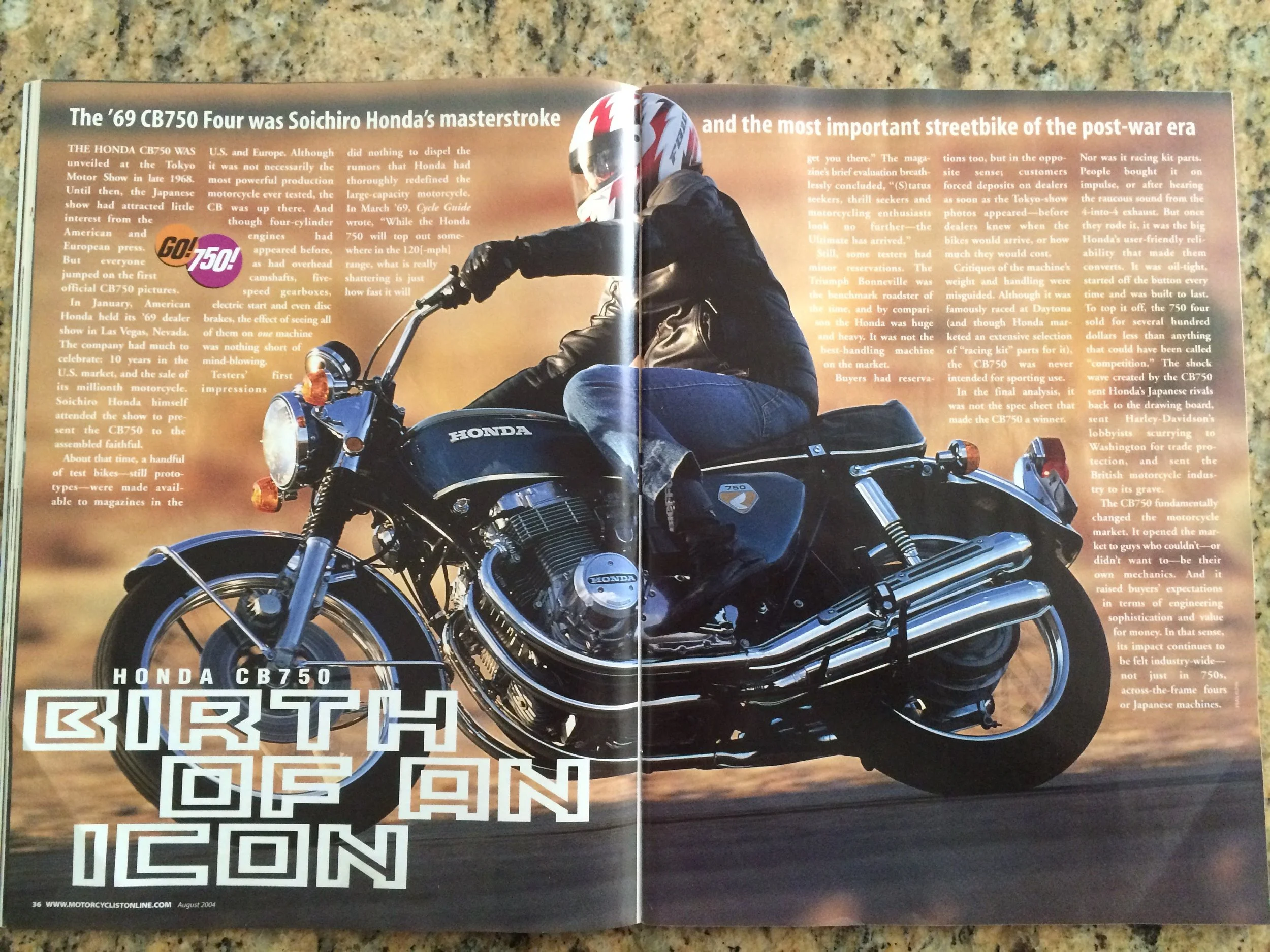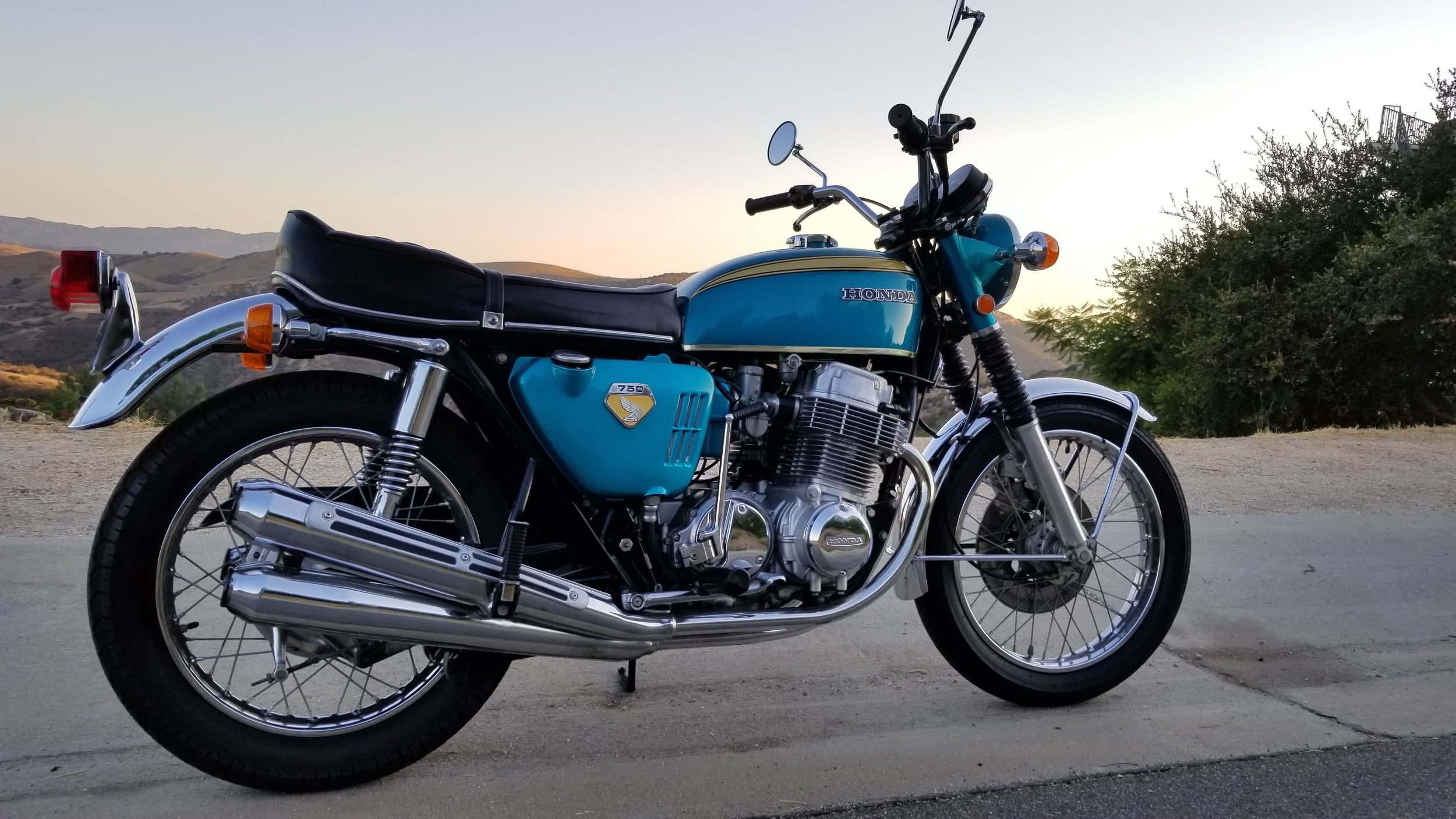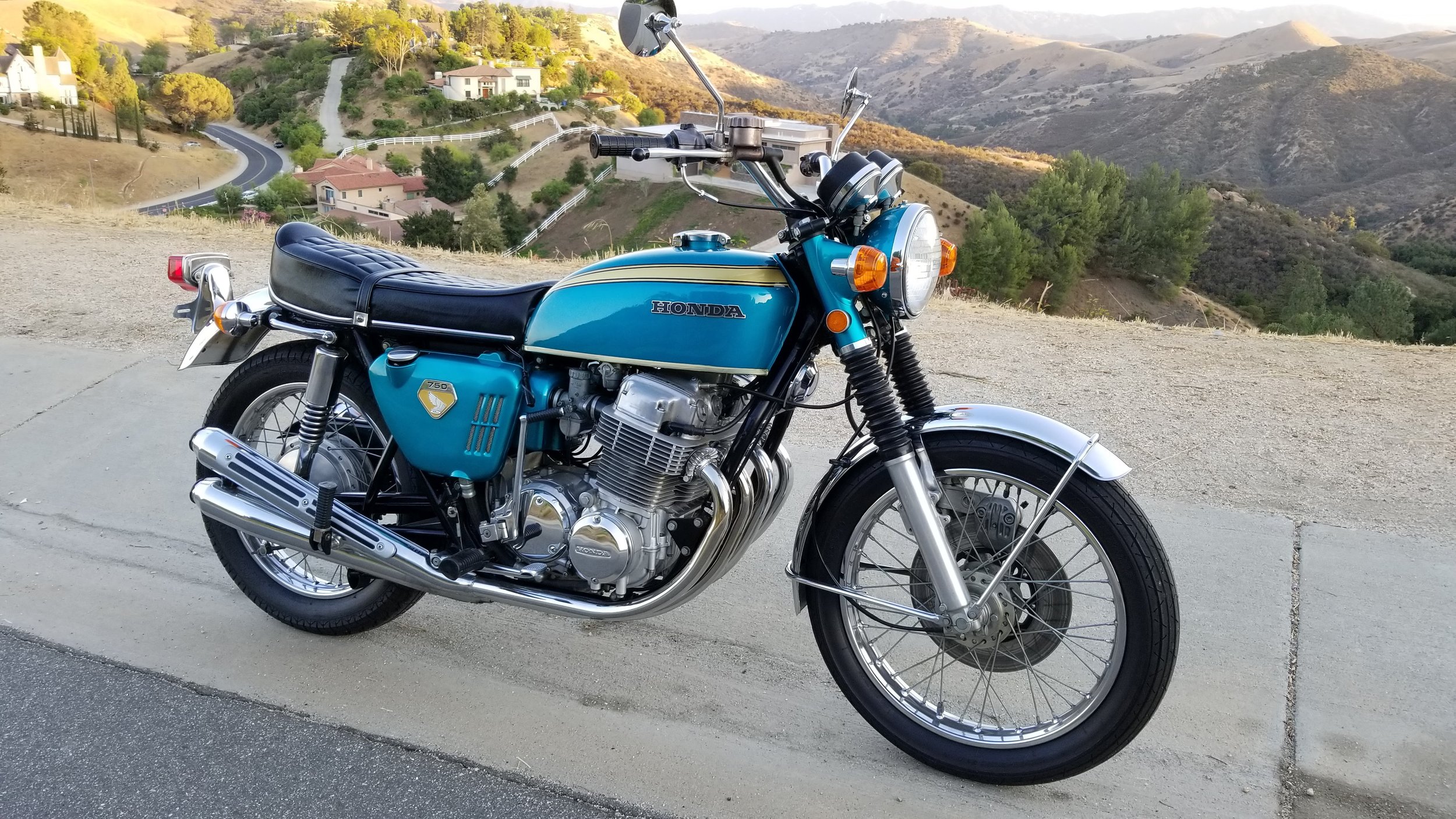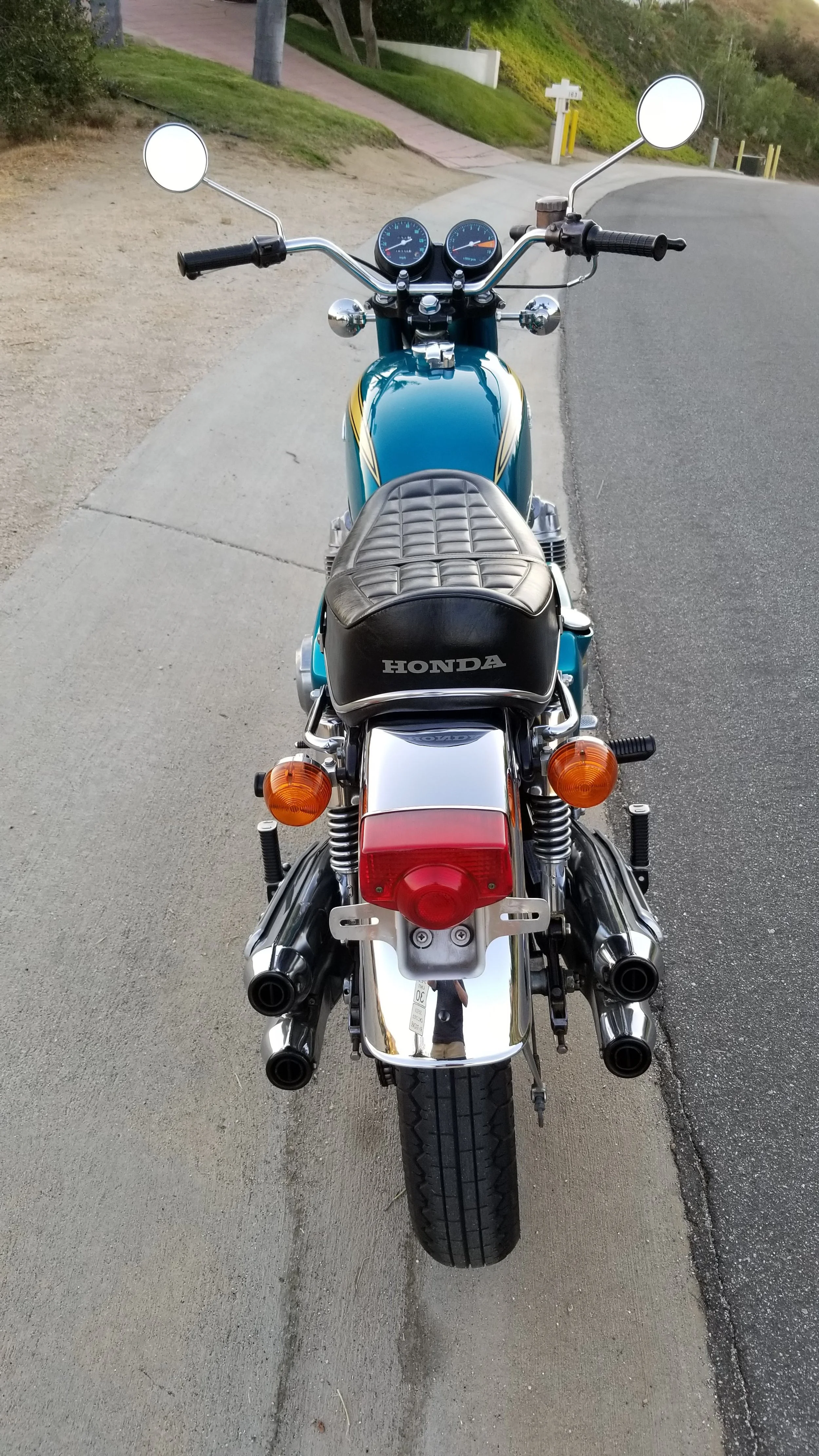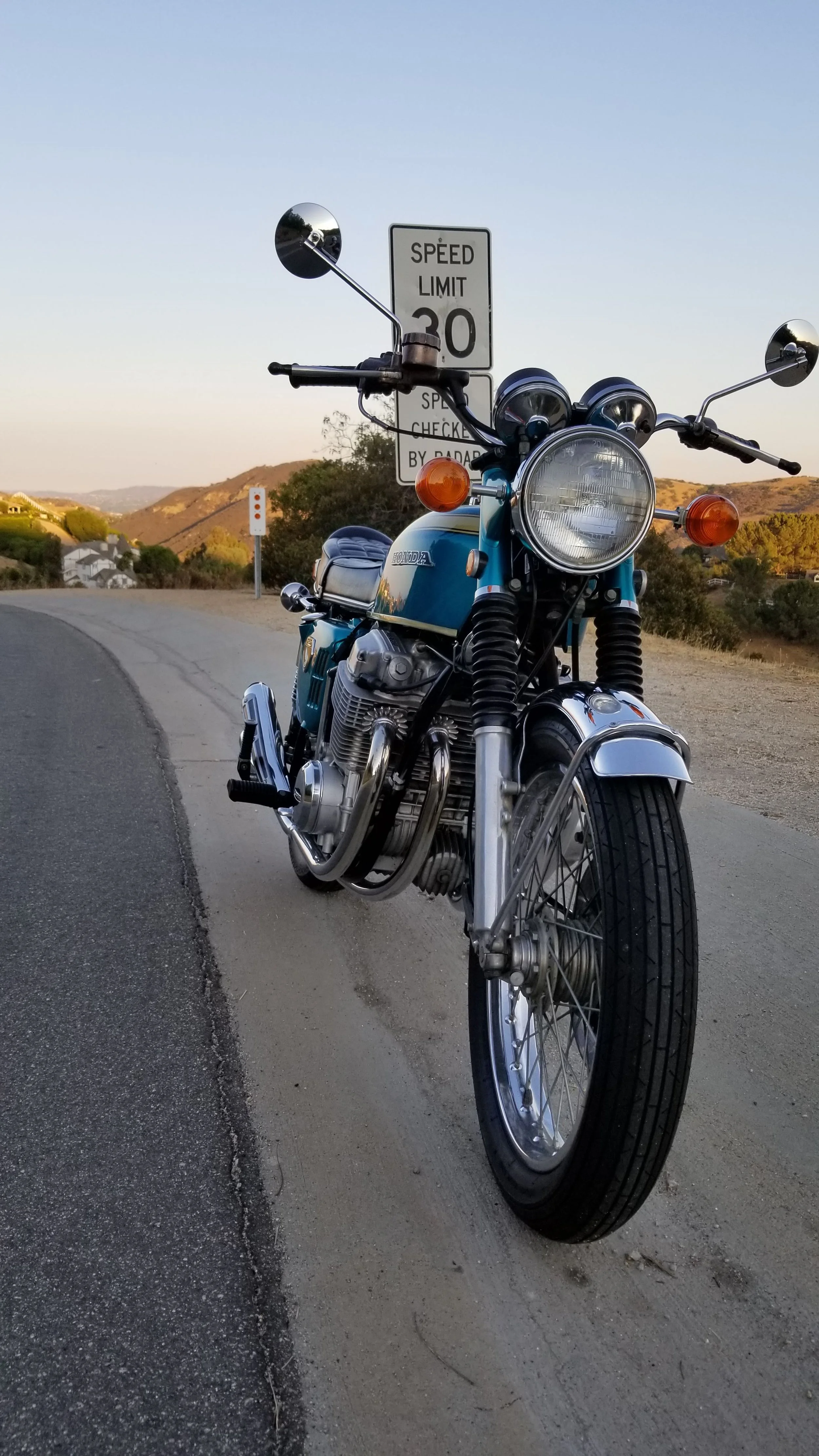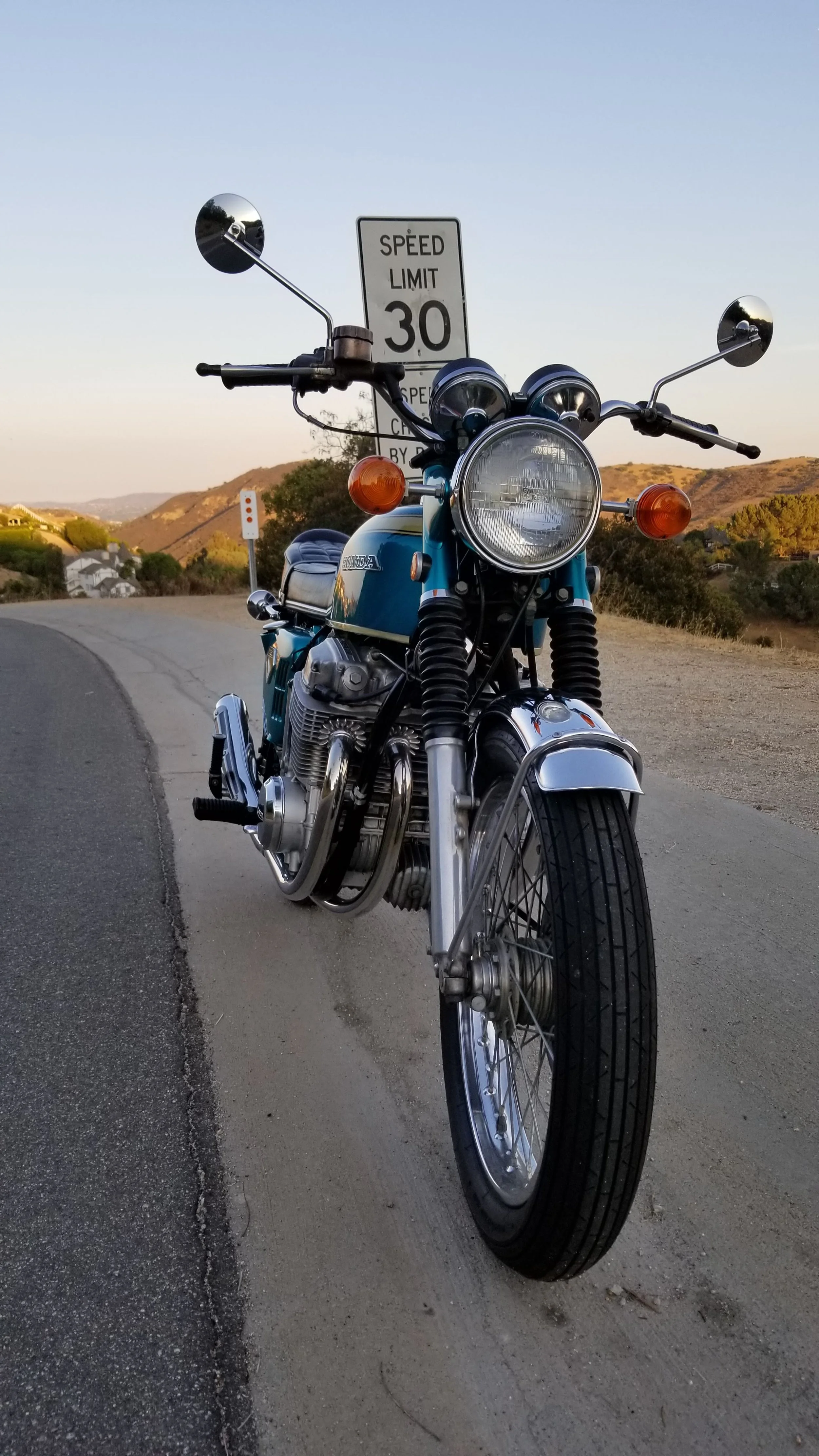1970 Honda CB 750 K0
Like many kids, I made the testosterone-fueled transition from bicycles to minibikes to Honda 90s around age 13 circa 1967. Already a budding scientist in school, I voraciously studied every book and magazine article on motorcycles and their technology that I could find. I applied my newfound knowledge of physics and chemistry to an understanding of how cars and motorcycles could provide so much fun! In the fall of 1968 all of the motorcycle magazines had pictures of a new motorcycle splashed across their covers that changed motorcycling forever. This motorcycle was the 1969 model Honda CB 750. For the motorcycle enthusiast of this time, gazing upon this cover stopped you dead in your tracks. One was compelled to start to look over what you were seeing in detail because you knew you were seeing something that as a whole and in the sum of its parts was revolutionary!
I remember seeing those first pictures and being enchanted first by the gorgeous cross frame transverse four cylinder overhead cam engine with four header pipes, four beautiful mufflers and four carburetors. This was the widest engine in a mass produced motorcycle made to that point in time. This engine, along with the bike’s large wide tank, broad seat, and substantial looking front suspension gave the motorcycle a most imposing and substantial look. The specifications were incredible: 67 hp, 736 cc single overhead cam transverse in-line four-cylinder engine, 480 pound dry weight, 58.5 inch wheelbase, front disc, rear drum brakes, electric start, 35 miles per gallon, and a top speed of 123 mile-per-hour. Simply put, the specifications of this first Honda CB 750 was simply unheard of in any other motorcycle produced in any quantity prior to that point in time. This bike was a game changer in every way you looked at it. Incredibly, Honda accomplished all this and was still able to offer it at an MSRP of $1,495.00!
Yes it was true that the Nortons, the BSA and Triumph triples of the era could frequently out accelerate and out handle the CB 750. I say frequently because these motorcycles couldn’t touch the Honda in terms of reliability and longevity and required very careful tuning and synchronization procedures to ensure they met their performance potential. It was also true that the two-stroke Kawasaki 500 triples could frequently out accelerate the Honda stoplight to stoplight. I say frequently because these motorcycles couldn’t touch the Honda in terms of the for mentioned reliability and longevity – many riders carried extra spark plugs in case the two-stroke motor fouled them. The Honda CB 750 was a paradigm shifter in its entire package.
The engineering was more automotive than motorcycle based. The wiring harness looked like it belonged on a Buick. Pulling off the left side battery and electrical panel cover revealed a beautifully designed and completely accessible electrical panel. Automotive style snap connectors allowed for reliable disconnection and reconnection as well as water resistance. The voltage regulator, AC to DC rectifier, the fuse box, and the starter relay switch were of the highest quality. Speaking of the starter switch, it would be several more years before the other major manufacturers incorporated electric starter motors as standard equipment into all their street motorcycles.
When I saw the bike for the first time in person, I realized that the pictures didn’t do the motorcycle justice. The paint was deeply lustrous and the chrome sparkled. The all-aluminum engine cases and the fins on the cylinders and engine head were beautifully casted. The instruments were canted back and were large and easily viewable. The clutch actuation was easy and linear as was the throttle pull. Every detail had been thoroughly thought through and engineered for reliability and longevity and performance. It was as though all the prior motorcycles had gone into a phone booth (like Clark Kent did in the Superman comic books) and came out in the fall of 1968 transformed into this super-machine. This was not just a motorcycle- it was a superbike!
The term superbike was undoubtedly bandied about around the time the 1969 Honda CB 750, the BSA and Triumph triples, the Kawasaki triple, and the new Norton commando made their debuts in 1968-1969. But the term became more cemented in the lexicon with the publication of the March 1970 Cycle Magazine issue. With a huge number seven on a white background the cover of the magazine proclaimed its intent to compare the seven biggest and fastest machines available among the 1969 models in a head-to-head, factory tuned, “Big Seven Superbike Comparison Test”. To the best of my knowledge this was the first major publication of automotive or motorcycle content to use the term superbike or supercar. Now the use of the prefix “super” is ubiquitous and these kinds of comparisons are commonplace. At the end of the comparison, the magazine did not reward an overall winner. They essentially stated that they had given enough information regarding the pros and cons and performance capabilities of each machine that would allow an individual to make their own decision. Many felt that Dick Mann's victory at the famed Daytona 200 of March, 1970, on the Honda 750 gave this motorcycle the title of superbike of the year.
History, undoubtedly, has awarded the Honda CB 750 the title of the most significant motorcycle in the history of motorcycling. Significant in the sense that the transverse in-line four-cylinder Japanese motorcycle (a.k.a.: Universal Japanese Motorcycle) became the best-selling motorcycles for the next 47 years. Significant in the sense that this one motorcycle was engineered to be competitive in all aspects of street motorcycling. Significant in the sense that it sold 553,400 CB 750s in its nine-year run from 1969 to 1978. For relatively expensive motorcycle those numbers are astounding! I remember a biology professor of mine saying that nature had evolved nearly 1 million animal species and that approximately 300,000 of those species were beetles. He deduced from that that the beetle design was the most effective at accomplishing the goals of any species; that is to live and compete in the ecosystem and reproduce effectively. In this sense, the Honda CB 750 is the beetle of the motorcycle marketplace ecosystem.
So it was with unbridled excitement that I purchased my first Honda CB 750 in Planet Metallic Blue. It was a very lightly used 1975 model that I purchased in the spring of 1977. I had just paid off my bank loan of $500 .00 on a 1972 Honda CL 450. I had toured all over the Midwest on the Honda 450, and it had proven to be a competent and reliable motorcycle. But the CB 750 was a different animal altogether. It seemed to glide down the road with the massive four-cylinder engine making its unmistakable sound – again, practically automotive, through its four-into-one Kerker exhaust. This machine was equally competent driving around town or spontaneously leaving town for 300 or 400 mile ride. Compared to almost any other motorcycle I had experienced it had a silky smoothness to its engine and a reassuring ride quality that was unique. In addition, the excellence of the engineering and its performance banished any thoughts that it may not start or get me to where I wanted to go at any time-which unfortunately had been all too uncommon with other motorcycles. Finally, though it was heavy and was not the best in the handling department, compared especially to the British bikes of the day, it could hold its own when the riding got sporty. A new set of high-performance rear shocks and that Kerker exhaust definitely helped in these circumstances. Remember, Dick Mann won the 1970 Daytona 500 on a CB 750. The reserved exhaust note at idle and under normal acceleration became a shrieking wail over 6500 RPM announcing to everyone within earshot that a superbike was here to save the day!
In the late 70s, a young man from Los Angeles purchased a low mile Candy Blue Green 1970 Honda CB 750 K0 from its original owner in the San Fernando Valley. Outside of a few minor changes and the usual maintenance the motorcycle had been kept in remarkably original condition. Serviced and detailed regularly by the original and second owner this motorcycle retains its nearly new appearing paint and chrome as factory original. This motorcycle was known in the Southern California area by CB 750 enthusiasts and the owner was asked by the editor of Motorcyclist magazine in 2004, Mitch Boehm, to have the bike featured in an article on the evolution of 750 cc motorcycles from the original Honda CB 750 onward. A beautiful full two-page spread of this Honda CB 750 was featured in the August 2004 edition gracefully leaning over into a turn. The shot, taken from the left side and down low, revealed this pristine machine’s beautiful lines and the engine’s cool – check out chapter 4 four cylinders and exhaust pipes elegantly flowing to the rear. Two years later on, after many years search for the right Honda CB 750 I received word that the owner was selling and was able to purchase this beautiful machine. This occurred in 2006, 40 years after I owned my first CB 750- both in blue!
I was very happy about the purchase for a number of reasons. I consider the 1970 K0 model to be the best of the breed. Even though it is not the “more collectible” sand cast model of the first 7414 made for the 1969 model year, it is identical in almost every way. It retains the classic pentagonal side covers and matching classic Honda winged emblem as opposed to the “script Four” logo. It retains the duckbill rear seat, a styling homage to many British (especially BSA ) motorcycles of the 1960s instead of the flat and formless seat of subsequent models. The diecast engine is actually stronger and less brittle than the sand cast model and has a brighter and cleaner look to the engine. Finally, I really don’t care if the center hump of the fuel tank that goes over the down tube is wrinkled like the 1969 models. Again, by far the most amazing aspect of this bike is that it is an original 1970 model K0 with original paint, original exhausts, and original chrome that are so nearly perfectly preserved that the most common question I get from people who see it is “who did the restoration?” I’m always delighted to answer this question with – What Restoration?
